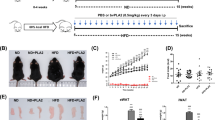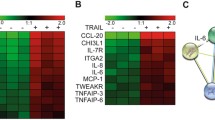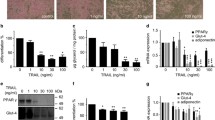Abstract
Objective
We previously reported that Androctonus australis hector (Aah) venom and its toxic fraction affect adipose tissue metabolism. However, the contribution of immune system and the role of adipose tissue macrophages (ATMs) in the progression of inflammation induced by scorpion venom remain largely unknown.
Methods
Here we evaluate the capacity of the toxic fraction of Aah venom (FTox-G50) to induce the expression of M1 and M2 markers genes on adipose tissue and isolated stromal vascular cells (SVC). Quantitative real-time PCR was performed on the SVC 24 h after FTox-G50 venom injection to assess the gene expressions of IL12p40, IL23, and other macrophages-associated markers.
Results
We found that ATM from FTox-G50-venom-injected mice markedly increased the expressions of IL-12p40 and IL-23. Furthermore, the expression of nitric oxide synthase 2 (an M1 marker) was up-regulated, but the expression of Arginase1 (an M2 marker) was not. Systemic injection of a chemical inhibitor directed against TNF-α binding reduced the expression of inflammatory M1 macrophage markers and the MAPKpk2 gene, a key mediator of inflammatory signaling.
Conclusion
These results indicate that TNF-α is a physiological regulator of inflammation and macrophage activation induced by scorpion venom.




Similar content being viewed by others
References
Gordon S, Martinez FO. Alternative activation of macrophages: mechanism and functions. Immunity. 2010;32:593–604.
Odegaard JI, Ricardo-Gonzalez RR, Goforth MH, et al. Macrophage-specific PPARgamma controls alternative activation and improves insulin resistance. Nature. 2007;447:1116–20.
Mantovani A, Schioppa T, Biswas SK, Marchesi F, Allavena P, Sica A. Tumor-associated macrophages and dendritic cells as prototypic type II polarized myeloid populations. Tumori. 2003;89:459–68.
Bronte V, Zanovello P. Regulation of immune responses by l-arginine metabolism. Nat Rev Immunol. 2005;5:641–54.
Gordon S. Alternative activation of macrophages. Nat Rev Immunol. 2003;3:23–35.
Fialho EM, Maciel MC, Silva AC, et al. Immune cells recruitment and activation by Tityus serrulatus scorpion venom. Toxicon Off J Int Soc Toxinol. 2011;58:480–5.
Fukuhara YD, Reis ML, Dellalibera-Joviliano R, Cunha FQ, Donadi EA. Increased plasma levels of IL-1beta, IL-6, IL-8, IL-10 and TNF-alpha in patients moderately or severely envenomed by Tityus serrulatus scorpion sting. Toxicon Off J Int Soc on Toxinol. 2003;41:49–55.
Jalali A, Pipelzadeh MH, Taraz M, Khodadadi A, Makvandi M, Rowan EG. Serum TNF-alpha levels reflect the clinical severity of envenomation following a Hemiscorpius lepturus sting. Eur Cytokine Netw. 2011;22:5–10.
Petricevich VL. Balance between pro- and anti-inflammatory cytokines in mice treated with Centruroides noxius scorpion venom. Mediators Inflamm. 2006;2006:54273.
Ishizuka EK, Ferreira MJ, Grund LZ, et al. Role of interplay between IL-4 and IFN-gamma in the in regulating M1 macrophage polarization induced by Nattectin. Int Immunopharmacol. 2012;14:513–22.
Zoccal KF, Bitencourt Cda S, Secatto A, et al. Tityus serrulatus venom and toxins Ts1, Ts2 and Ts6 induce macrophage activation and production of immune mediators. Toxicon Off J Int Soc Toxinol. 2011;57:1101–8.
Zoccal KF, Bitencourt Cda S, Paula-Silva FW, et al. TLR2, TLR4 and CD14 recognize venom-associated molecular patterns from Tityus serrulatus to induce macrophage-derived inflammatory mediators. PLoS One. 2014;9:e88174.
Adi-Bessalem S, Mendil A, Hammoudi-Triki D, Laraba-Djebari F. Lung immunoreactivity and airway inflammation: their assessment after scorpion envenomation. Inflammation. 2012;35:501–8.
Ait-Lounis A, Laraba-Djebari F. TNF-alpha involvement in insulin resistance induced by experimental scorpion envenomation. PLoS Negl Tropical Dis. 2012;6:e1740.
Raouraoua-Boukari R, Sami-Merah S, Hammoudi-Triki D, Martin-Eauclaire MF, Laraba-Djebari F. Immunomodulation of the inflammatory response induced by Androctonus australis hector neurotoxins: biomarker interactions. NeuroImmunoModul. 2012;19:103–10.
Laraba-Djebari F, Hammoudi D. Use of toxic fraction isolated from Algerian Androctonus australis hector scorpion venom for the assessment of anti-venom serum. Archives de l’Institut Pasteur d’Algerie Institut Pasteur d’Algerie. 1998;62:254–66.
Djeraba A, Kut E, Rasschaert D, Quere P. Antiviral and antitumoral effects of recombinant chicken myelomonocytic growth factor in virally induced lymphoma. Int Immunopharmacol. 2002;2:1557–66.
Cohen CR, Moscicki AB, Scott ME, et al. Increased levels of immune activation in the genital tract of healthy young women from sub-Saharan Africa. AIDS. 2010;24:2069–74.
de Boer JF, Dikkers A, Jurdzinski A, et al. Mitogen-activated protein kinase-activated protein kinase 2 deficiency reduces insulin sensitivity in high-fat diet-fed mice. PLoS One. 2014;9:e106300.
Xu H, Barnes GT, Yang Q, et al. Chronic inflammation in fat plays a crucial role in the development of obesity-related insulin resistance. J Clin Investig. 2003;112:1821–30.
Caspar-Bauguil S, Cousin B, Galinier A, et al. Adipose tissues as an ancestral immune organ: site-specific change in obesity. FEBS Lett. 2005;579:3487–92.
Park HT, Lee ES, Cheon YP, et al. The relationship between fat depot-specific preadipocyte differentiation and metabolic syndrome in obese women. Clin Endocrinol. 2012;76:59–66.
Cohen CA, Shea AA, Heffron CL, Schmelz EM, Roberts PC. Intra-abdominal fat depots represent distinct immunomodulatory microenvironments: a murine model. PLoS One. 2013;8:e66477.
Hevener AL, Olefsky JM, Reichart D, et al. Macrophage PPAR gamma is required for normal skeletal muscle and hepatic insulin sensitivity and full antidiabetic effects of thiazolidinediones. J Clin Investig. 2007;117:1658–69.
Lumeng CN, Bodzin JL, Saltiel AR. Obesity induces a phenotypic switch in adipose tissue macrophage polarization. J Clin Investig. 2007;117:175–84.
Krausgruber T, Blazek K, Smallie T, et al. IRF5 promotes inflammatory macrophage polarization and TH1-TH17 responses. Nat Immunol. 2011;12:231–8.
Hadaddezfuli R, Khodadadi A, Assarehzadegan MA, Pipelzadeh MH, Saadi S. Hemiscorpius lepturus venom induces expression and production of interleukin-12 in human monocytes. Toxicon Off J Int Soc Toxinol. 2015;100:27–31.
Bronte V, Kasic T, Gri G, et al. Boosting antitumor responses of T lymphocytes infiltrating human prostate cancers. J Exp Med. 2005;201:1257–68.
Palm NW, Medzhitov R. Role of the inflammasome in defense against venoms. Proc Natl Acad Sci USA. 2013;110:1809–14.
Lumeng CN, Deyoung SM, Saltiel AR. Macrophages block insulin action in adipocytes by altering expression of signaling and glucose transport proteins. Am J physiol Endocrinol Metabol. 2007;292:E166–74.
Wang H, Peters T, Kess D, et al. Activated macrophages are essential in a murine model for T cell-mediated chronic psoriasiform skin inflammation. J Clin Investig. 2006;116:2105–14.
Acknowledgments
This study was funded by the National Commission for the Evaluation of University Research Projects “CNEPRU grant” number F00220130056. We are grateful to Isabelle Dunand-Sauthier (University of Geneva) for providing the primers sequences to perform quantitative RT-PCR. We are also grateful to Karim Bouzakri (University of Geneva) to providing TNF-α antagonist “Etanercept.”
Author information
Authors and Affiliations
Corresponding author
Ethics declarations
Conflict of interest
The authors declare that they have no conflict of interest.
Additional information
Responsible Editor: John Di Battista.
Rights and permissions
About this article
Cite this article
Ait-Lounis, A., Laraba-Djebari, F. TNF-alpha modulates adipose macrophage polarization to M1 phenotype in response to scorpion venom. Inflamm. Res. 64, 929–936 (2015). https://doi.org/10.1007/s00011-015-0876-z
Received:
Revised:
Accepted:
Published:
Issue Date:
DOI: https://doi.org/10.1007/s00011-015-0876-z




